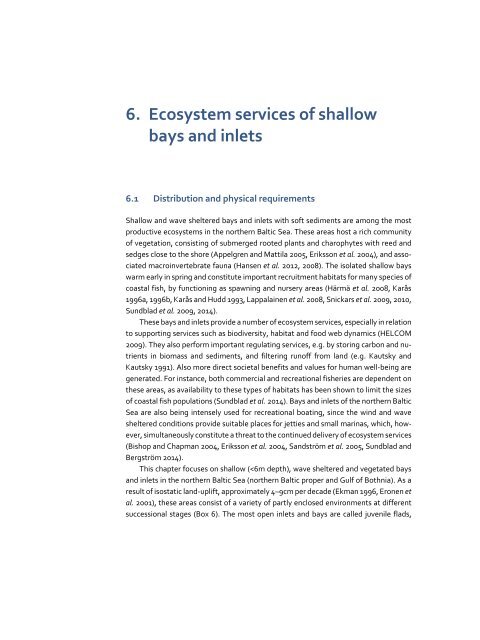Ecosystem Services
FULLTEXT01
FULLTEXT01
Create successful ePaper yourself
Turn your PDF publications into a flip-book with our unique Google optimized e-Paper software.
6. <strong>Ecosystem</strong> services of shallow<br />
bays and inlets<br />
6.1 Distribution and physical requirements<br />
Shallow and wave sheltered bays and inlets with soft sediments are among the most<br />
productive ecosystems in the northern Baltic Sea. These areas host a rich community<br />
of vegetation, consisting of submerged rooted plants and charophytes with reed and<br />
sedges close to the shore (Appelgren and Mattila 2005, Eriksson et al. 2004), and associated<br />
macroinvertebrate fauna (Hansen et al. 2012, 2008). The isolated shallow bays<br />
warm early in spring and constitute important recruitment habitats for many species of<br />
coastal fish, by functioning as spawning and nursery areas (Härmä et al. 2008, Karås<br />
1996a, 1996b, Karås and Hudd 1993, Lappalainen et al. 2008, Snickars et al. 2009, 2010,<br />
Sundblad et al. 2009, 2014).<br />
These bays and inlets provide a number of ecosystem services, especially in relation<br />
to supporting services such as biodiversity, habitat and food web dynamics (HELCOM<br />
2009). They also perform important regulating services, e.g. by storing carbon and nutrients<br />
in biomass and sediments, and filtering runoff from land (e.g. Kautsky and<br />
Kautsky 1991). Also more direct societal benefits and values for human well-being are<br />
generated. For instance, both commercial and recreational fisheries are dependent on<br />
these areas, as availability to these types of habitats has been shown to limit the sizes<br />
of coastal fish populations (Sundblad et al. 2014). Bays and inlets of the northern Baltic<br />
Sea are also being intensely used for recreational boating, since the wind and wave<br />
sheltered conditions provide suitable places for jetties and small marinas, which, however,<br />
simultaneously constitute a threat to the continued delivery of ecosystem services<br />
(Bishop and Chapman 2004, Eriksson et al. 2004, Sandström et al. 2005, Sundblad and<br />
Bergström 2014).<br />
This chapter focuses on shallow (


